Nexus 9 Review
Nexus 9
Not quite the landmark Android tablet we were hoping for
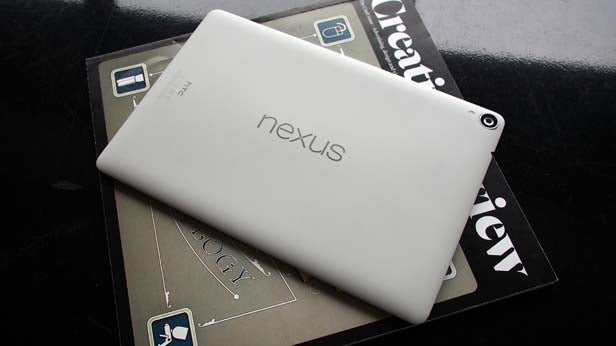
Sections
- Page 1 Nexus 9 Review
- Page 2 Screen Quality Review
- Page 3 Android 5.0 Lollipop Review
- Page 4 Performance Review
- Page 5 Battery Life and Verdict Review
Verdict
Pros
- Big, sharp screen
- Powerful GPU
- Good battery life
Cons
- Not as swish as an iPad
- Backlight leakage
- Slightly disappointing stereo speakers
Key Specifications
- Review Price: £319.00
- 8.9-inch 4:3 IPS LCD 2048 x 1536 screen
- 8MP rear camera with LED flash, 1.6MP front camera
- Nvidia Tegra K1 processor with 2GB RAM
- Metal trimmed with soft-touch plastic back
- Android 5.0 Lollipop
- BoomSound stereo speakers
- 425g, 7.9mm thick
First reviewed: November 2014
What is the Nexus 9?
The Nexus 9 is Google’s 8.9-inch flagship tablet, released in November 2014. It’s the first of the Nexus troupe to use a 4:3-ratio screen rather than a widescreen one and the first to launch with Android 5.0 Lollipop.
The Nexus 9 isn’t the market-defining bargain that the Nexus 7 was, and a £319 price tag may be enough to discourage Nexus 7 users from upgrading. The price has since dropped to a shade below the £300 mark, but we still believe the iPad Air 2 is a much more complete and coherent option. User reviews up to now have mentioned a number of little issues here and there, and while the price hovers around the £300 mark – you can buy the Nexus 9 for under £300 from Currys – we feel there are better options available.
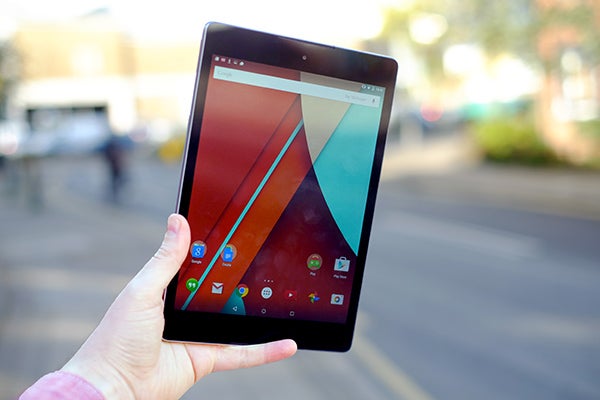
What we do like is the direction in which the Nexus 9 is taking Google’s tablets. 8-inch-plus non-widescreen tablets like this will no longer be small-brand oddities, and that’s a very good thing. We don’t think it’ll take the Nexus 9 18 months to be topped for value, and the Samsung Galaxy Tab S 8.4 is already a rather compelling alternative. But for a larger device, the Nexus 9 offers up a solid go-to standard.
Watch our Nexus 9 video review
Nexus 9: Design
The Nexus 9 sets itself up for criticism. Its style and shape are pretty similar to the iPad Air 2, a departure for the Nexus series.
This in itself is a good move. Larger tablets feel a lot more natural when they adopt a less-widescreen aspect: both the Nexus 7 and Nexus 10 are 16:10 ratio, the Nexus 9 is 4:3. 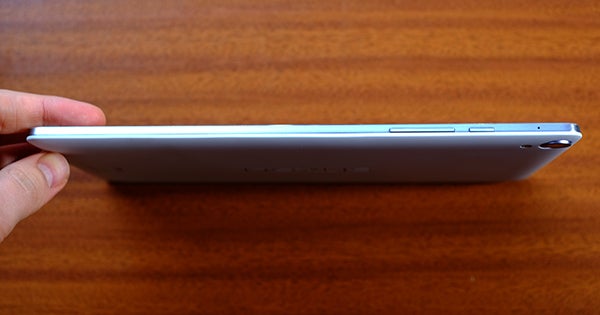
However, the Nexus 9 doesn’t offer quite as impressive build quality as an iPad, and when the design similarities are so clear, it’s hard not to compare the two directly despite their differing platforms.
You may bring up price difference (£80), but also consider that the still-pretty-great first-gen iPad Air costs now exactly the same amount as the Nexus 9, £319. To explain, let’s look a little closer at the Nexus 9’s hardware design.
Much like the Nexus 7, the Nexus 9 uses a plastic back cover, one that that’s firmly strapped into a metal frame that runs around the tablet. It’s a fairly innocuous design, and despite using a very mild soft-touch textured finish, it still feels conspicuously like plastic. 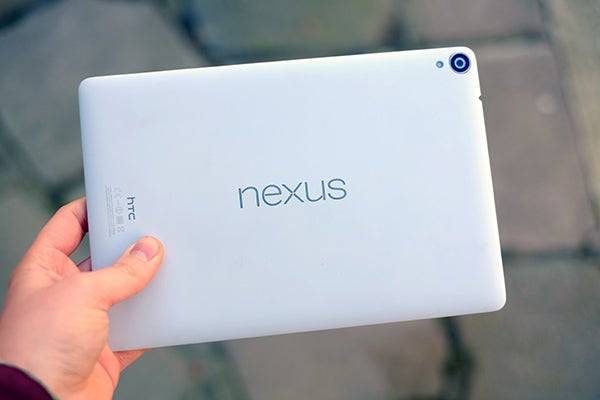
We’re also slightly disappointed with some of the finishing elements, given how much more expensive this tablet is compared to the Nexus 7. The plastic rear flexes at certain points, even producing a slightly disconcerting clicking noise towards the top of the tablet, and there’s a roughness to the metal frame as it pokes ever-so-slightly above the screen glass.
The volume keys too feel a little cheap, the action slightly misjudged and shallow, even if they are metal. This may be us simply grasping for explanations, but HTC’s relative inexperience may be to blame: it makes the Nexus 9 and hasn’t released a tablet since the 2011 HTC Flyer.
While we have no particular worries about the longevity of the Nexus 9 – it doesn’t feel poorly made, just not all that well finished – it seems like a bit of a middleweight contender for what is meant to be the standard-setting Android tablet flagship. We’ll see other elements that suffer from this sort of vibe later on.
It’s not just the iPad Air 2 the Nexus 9 needs to compete with, either. The Nexus 9 is 7.9mm thick and 425g (Wi-Fi), a load heftier than the 6.6mm thick, 294g Samsung Galaxy Tab S 8.4 – the Samsung is smaller, but still a good size. The Nexus 9 is arguably just not leading the pack in the way it really should be. 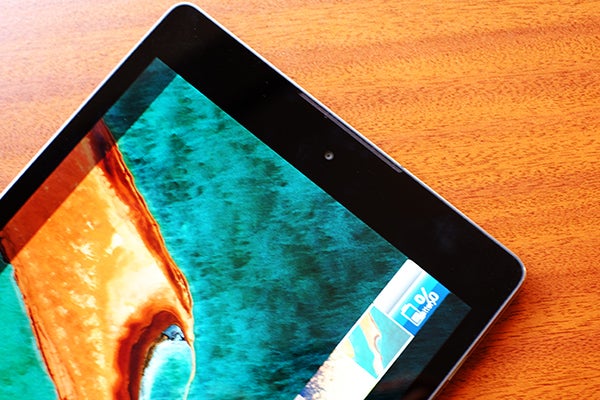
However, cast away those comparisons and in real-life use the Nexus 9 is pretty good. The non-widescreen aspect is great, there’s just enough side bezel to rest your thumb on, and it’s very comfortable to use, especially if you have both hands spare or are sitting down.
Like the iPad Air 2, which is a somewhat-similar weight, you can use it one-handed for a while without discomfort, but it’s far off the feather-lightness of the 8.4-inch Samsung or the iPad Mini 2/3 (we recommend the former, by the way).
Just like the Nexus 7, the Nexus 9 leaves out a microSD card slot. There are 16GB and 32GB versions of the tablet, with a slightly disappointing £80 gap between the two. That’s even more than Apple charges: you get a bump up to the 64GB iPad Air 2 for £80. Who’d have thought Google would charge even more than Apple’s often notoriously-pricey upgrades?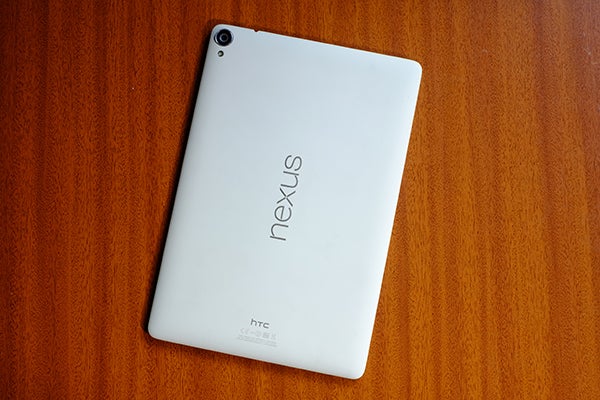
Step back a minute, and we can see the factors behind the Nexus 9’s failing to offer the market-defining package we’re after. It doesn’t offer class-leading value or class-leading design, and doesn’t have all the geek-friendly features that might excuse these two points.
The hardware spec list is relatively simple too. There’s no IR transmitter, for example – something found on the Galaxy Tab S 8.4. If this is all sounding terribly negative, you need to understand it in with context of the weight of expectation laid on the Nexus 9. It’s not just meant to be ‘an’ Android tablet, it’s meant to be ‘the’ Android tablet.
So far: good, not superb. 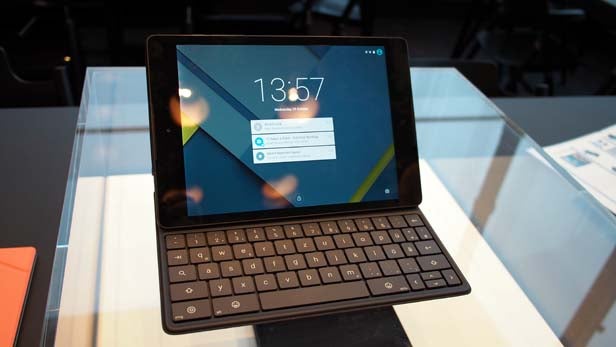
Google is also to offer a Nexus 9 folio keyboard case, which comes with solid keyboard action even if typing on it can feel a little cramped. It’s not cheap at £110, but bumps up the tablet’s potential as a portable productivity tool.
How we test tablets
We test every tablet we review thoroughly. We use industry standard tests to compare features properly and we use the tablet as our main device over the review period. We’ll always tell you what we find and we never, ever, accept money to review a product.


